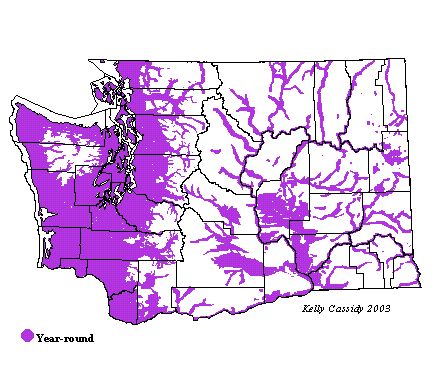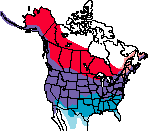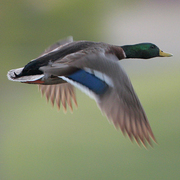Mallard
General Description
Perhaps the most familiar duck in the Northwest, the Mallard is a large and heavy bird. Males have gray bodies with chestnut-brown breasts, white collars, iridescent-green heads, and yellow bills. Females are mottled brown-and-black with lighter brown heads and necks and yellow bills mottled with black. They have a black stripe running horizontally through the eye. Both sexes have orange feet and a blue speculum, or wing-patch, bordered in white on two sides, best seen in flight. From June to September, immatures and males, which are then in non-breeding (eclipse) plumage, look much like females.
Habitat
Shallow marshes are the preferred habitat, although Mallards are found virtually everywhere there is open water, from city parks to subalpine lakes. Although they favor fresh water, they are also often found in sheltered bays and estuaries along the coast.
Behavior
Mallards forage by up-ending in shallow water and by grazing on land. Mallard pairs form in the fall and winter, and remain intact through the winter and into spring. Pair bonds tend to break up, however, when the female begins incubating eggs.
Diet
Mallards are omnivorous, eating seeds, stems, and roots from a variety of aquatic plants, especially sedges, grasses, pondweeds, and smartweeds. Insect larvae and other aquatic invertebrates are also part of the diet, especially the diet of young birds. In many places, humans provide Mallards with food year round.
Nesting
The female usually picks a nest site that is close to water, but may be over a mile away. Typically situated on the ground under dense vegetation, the nest is sometimes on a stump, platform, or even up to 10 feet off the ground in a tree. It is usually a shallow bowl of plant matter, lined with down. The female typically lays 7 to 10 eggs, which she incubates for 26 to 30 days. Within a day of hatching, the young leave the nest. The female leads the young to the water and continues to tend them, and they feed themselves. The young first fly at 52 to 60 days.
Migration Status
Mallards will remain as far north in winter as conditions permit, and many populations that are fed by people do not migrate. Those that do migrate do so early in spring. Most birds are heading from wintering grounds to breeding areas in February and March. The fall migration is more drawn out. Males leave their mates when incubation begins (as early as mid-March) and gather in large wetlands where they molt into their non-breeding or eclipse plumage and go through a flightless period. The actual migration movement begins in late August and lasts through December, with peak movements in October and November.
Conservation Status
Although numbers fluctuate considerably and are probably reduced from historical levels, the Mallard is still one of the most abundant ducks in the world. It is a generalist and has adapted to living in close association with humans. Numbers have increased historically in eastern North America.
When and Where to Find in Washington
The Mallard is the most widespread and common duck in Washington and can be found on virtually any lowland wetland throughout the state year round, as long as there is open water.
 Abundance
Abundance
| Ecoregion | Jan | Feb | Mar | Apr | May | Jun | Jul | Aug | Sep | Oct | Nov | Dec |
|---|---|---|---|---|---|---|---|---|---|---|---|---|
| Oceanic | ||||||||||||
| Pacific Northwest Coast | C | C | C | C | C | C | C | C | C | C | C | C |
| Puget Trough | C | C | C | C | C | C | C | C | C | C | C | C |
| North Cascades | C | C | C | C | C | F | F | F | F | F | C | C |
| West Cascades | C | C | C | C | C | C | C | C | C | C | C | C |
| East Cascades | C | C | C | C | C | C | C | C | C | C | C | C |
| Okanogan | C | C | C | C | C | C | C | C | C | C | C | C |
| Canadian Rockies | C | C | C | C | C | C | C | C | C | C | C | C |
| Blue Mountains | F | F | F | F | F | F | U | U | ||||
| Columbia Plateau | C | C | C | C | C | C | C | C | C | C | C | C |
Washington Range Map

North American Range Map


Family Members
 Fulvous Whistling-DuckDendrocygna bicolor
Fulvous Whistling-DuckDendrocygna bicolor Taiga Bean-GooseAnser fabalis
Taiga Bean-GooseAnser fabalis Greater White-fronted GooseAnser albifrons
Greater White-fronted GooseAnser albifrons Emperor GooseChen canagica
Emperor GooseChen canagica Snow GooseChen caerulescens
Snow GooseChen caerulescens Ross's GooseChen rossii
Ross's GooseChen rossii BrantBranta bernicla
BrantBranta bernicla Cackling GooseBranta hutchinsii
Cackling GooseBranta hutchinsii Canada GooseBranta canadensis
Canada GooseBranta canadensis Mute SwanCygnus olor
Mute SwanCygnus olor Trumpeter SwanCygnus buccinator
Trumpeter SwanCygnus buccinator Tundra SwanCygnus columbianus
Tundra SwanCygnus columbianus Wood DuckAix sponsa
Wood DuckAix sponsa GadwallAnas strepera
GadwallAnas strepera Falcated DuckAnas falcata
Falcated DuckAnas falcata Eurasian WigeonAnas penelope
Eurasian WigeonAnas penelope American WigeonAnas americana
American WigeonAnas americana American Black DuckAnas rubripes
American Black DuckAnas rubripes MallardAnas platyrhynchos
MallardAnas platyrhynchos Blue-winged TealAnas discors
Blue-winged TealAnas discors Cinnamon TealAnas cyanoptera
Cinnamon TealAnas cyanoptera Northern ShovelerAnas clypeata
Northern ShovelerAnas clypeata Northern PintailAnas acuta
Northern PintailAnas acuta GarganeyAnas querquedula
GarganeyAnas querquedula Baikal TealAnas formosa
Baikal TealAnas formosa Green-winged TealAnas crecca
Green-winged TealAnas crecca CanvasbackAythya valisineria
CanvasbackAythya valisineria RedheadAythya americana
RedheadAythya americana Ring-necked DuckAythya collaris
Ring-necked DuckAythya collaris Tufted DuckAythya fuligula
Tufted DuckAythya fuligula Greater ScaupAythya marila
Greater ScaupAythya marila Lesser ScaupAythya affinis
Lesser ScaupAythya affinis Steller's EiderPolysticta stelleri
Steller's EiderPolysticta stelleri King EiderSomateria spectabilis
King EiderSomateria spectabilis Common EiderSomateria mollissima
Common EiderSomateria mollissima Harlequin DuckHistrionicus histrionicus
Harlequin DuckHistrionicus histrionicus Surf ScoterMelanitta perspicillata
Surf ScoterMelanitta perspicillata White-winged ScoterMelanitta fusca
White-winged ScoterMelanitta fusca Black ScoterMelanitta nigra
Black ScoterMelanitta nigra Long-tailed DuckClangula hyemalis
Long-tailed DuckClangula hyemalis BuffleheadBucephala albeola
BuffleheadBucephala albeola Common GoldeneyeBucephala clangula
Common GoldeneyeBucephala clangula Barrow's GoldeneyeBucephala islandica
Barrow's GoldeneyeBucephala islandica SmewMergellus albellus
SmewMergellus albellus Hooded MerganserLophodytes cucullatus
Hooded MerganserLophodytes cucullatus Common MerganserMergus merganser
Common MerganserMergus merganser Red-breasted MerganserMergus serrator
Red-breasted MerganserMergus serrator Ruddy DuckOxyura jamaicensis
Ruddy DuckOxyura jamaicensis

